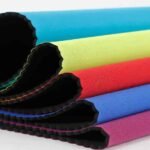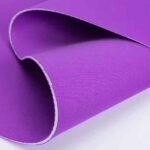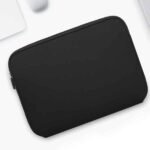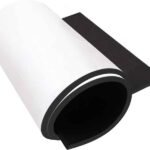If you’ve ever shopped for materials used in wetsuits, fashion garments, or high-performance accessories, you may have come across both scuba fabric and neoprene. While these two materials are often mentioned together, they serve very different purposes and have unique characteristics. In this article, we’ll explore what makes scuba fabric and neoprene distinct, compare their benefits and applications, and help you determine which one is best for your needs.
What Is Neoprene Fabric?

Neoprene fabric is a synthetic rubber material developed in the 1930s. Its scientific name is polychloroprene, and it’s made by polymerizing chloroprene. This process creates a material that is highly elastic, waterproof, and resistant to various environmental factors. Neoprene fabric is typically laminated with another textile, like nylon or polyester, which gives it additional strength and durability. The laminated version of neoprene fabric is what’s commonly used in commercial products.
Neoprene is best known for its use in wetsuits, where its thermal insulation properties keep divers and surfers warm in cold water. Beyond wetsuits, neoprene fabric is also found in laptop sleeves, protective gear, medical braces, and industrial products. Its combination of flexibility, water resistance, and temperature stability makes it a versatile material for numerous applications.
What Is Another Name For Neoprene Fabric?
Neoprene is also frequently called polychloroprene or neoprene rubber. While “neoprene” has become the widely accepted common name, “polychloroprene” is the technical term. When referring to the laminated form used in consumer goods, some people may simply call it “neoprene fabric” or “neoprene laminate.”
What Is Scuba Fabric?

Scuba fabric is a double-knit textile made from polyester and spandex. It was named after its resemblance to the smooth surface of neoprene wetsuits, but it is not actually a rubber-based material. Instead, scuba fabric has a sleek, smooth finish on both sides, which gives it a polished, modern appearance. It’s heavier than typical jersey or interlock knits, and this structure makes it ideal for garments that require a bit of stretch and a clean, structured look.
Scuba fabric is commonly used in fashion items such as dresses, skirts, and fitted jackets. Its stretchiness and body-contouring properties make it a favorite for creating modern, form-fitting styles. It is also wrinkle-resistant, making it practical for travel and everyday wear.
What Is Another Name For Scuba Fabric?
Scuba fabric may also be referred to as scuba knit or scuba crepe. These names indicate different weights or finishes of the fabric, but all share the same smooth, structured, and slightly stretchable characteristics. In the garment industry, the term “scuba knit” is often used interchangeably with “scuba fabric.”
What Is Similar To Scuba Fabric?
Fabrics that resemble scuba fabric include ponte knit, techno fabric, and double-knit jersey. These materials share scuba’s smooth surface and structured feel, although they differ slightly in weight and flexibility. Ponte knit, for instance, is often used for similar garment types and provides a comparable level of durability and shape retention.
Is Scuba Fabric The Same As Neoprene?
No, scuba fabric and neoprene are not the same. While they might appear similar at first glance due to their smooth surface, they differ in composition and performance. Neoprene is a rubber-based material known for its water resistance and insulation. Scuba fabric, on the other hand, is a textile made from polyester and spandex, with no rubber content. It is designed for fashion and everyday use rather than performance in extreme conditions.
The two materials also have different manufacturing processes. Neoprene involves chemical polymerization and lamination, resulting in a dense, rubbery material. Scuba fabric is produced through knitting, creating a lightweight, breathable fabric. In summary, although their names and appearances can be confusing, scuba fabric and neoprene serve very different purposes and are made from distinct materials.
What Is Scuba Fabric Good For?

Scuba fabric is ideal for creating structured, modern garments. Designers frequently use it for dresses, skirts, jackets, and activewear. Its stretch and smooth finish make it suitable for form-fitting styles that need a clean, polished look. Additionally, scuba fabric’s wrinkle resistance makes it easy to maintain, which is why it is often used in travel-friendly clothing and everyday fashion.
Its versatility extends to athletic wear, where it provides comfort and flexibility without the bulk of thicker materials. For example, scuba fabric leggings and tops are popular in the athleisure market. It is also used in accessories like tote bags, where a smooth and durable material is desired. In short, scuba fabric’s combination of stretch, durability, and sleek appearance makes it an excellent choice for a wide range of modern, stylish designs.
How Is The Different For Scuba Fabric And Neoprene?

Scuba fabric and neoprene differ in multiple aspects including material composition, structure, applications, environmental impact, and maintenance. Below is a detailed comparison:
| Aspect | Scuba Fabric | Neoprene |
|---|---|---|
| Material Composition | Polyester and spandex knit | Synthetic rubber (polychloroprene), often laminated with nylon or polyester |
| Structure and Weight | Lightweight, smooth, and breathable knit | Dense, foam-like material with rubber-like properties |
| Applications | Fashion garments (dresses, skirts, jackets), activewear, accessories | Wetsuits, laptop sleeves, industrial and medical products |
| Performance | Stretchy, wrinkle-resistant, comfortable | Waterproof, insulating, durable in extreme conditions |
| Breathability | High | Low (not breathable due to foam structure) |
| Care and Maintenance | Machine washable, easy to maintain | Requires gentle cleaning to preserve water resistance and structure |
| Environmental Impact | Typically lower, no petroleum-based core | Higher due to petroleum-based production, though eco-friendly alternatives are emerging |
How Is The Manufacturing Process Different For Scuba Fabric And Neoprene?
-
Scuba Fabric Manufacturing:
- Scuba fabric is produced through a knitting process that combines polyester and spandex fibers.
- The fibers are knitted together into a double-knit fabric, which results in its smooth surface and stretchable nature.
- The manufacturing process is similar to creating other knit fabrics but results in a thicker, more structured textile.
-
Neoprene Manufacturing:
- Neoprene is made through the chemical polymerization of chloroprene, forming a flexible synthetic rubber.
- The rubber is then expanded into foam using a process called foaming, which introduces gas bubbles to create the characteristic neoprene structure.
- Afterward, the foam is laminated with textiles (usually nylon or polyester) to add strength, durability, and aesthetic appeal.
- Neoprene production involves more complex chemical steps and equipment compared to scuba fabric knitting.
Environmental Performance
- Scuba Fabric:
Scuba fabric typically has a lower environmental impact since it is made from common polyester and spandex blends. Recycling options and eco-friendly alternatives are increasingly available. - Neoprene:
Traditional neoprene production is more resource-intensive and involves petroleum-based inputs. Some newer, plant-based alternatives (such as Yulex) aim to reduce the environmental footprint of neoprene products.
Applications and Use Cases
- Scuba Fabric:
Scuba fabric is primarily used in fashion. It works well for garments requiring structure and stretch, including fitted dresses, skirts, and tailored jackets. It is also used in activewear and travel-friendly clothing due to its wrinkle resistance. - Neoprene:
Neoprene is designed for performance-oriented uses. It is the go-to material for wetsuits because it provides thermal insulation and water resistance. Beyond water sports, it is used in medical supports, protective cases, and industrial gear where durability and flexibility are paramount.
Maintenance and Longevity
- Scuba Fabric:
Scuba fabric is straightforward to maintain. It is often machine washable, resists wrinkles, and holds its shape well after repeated washes. - Neoprene:
Neoprene requires more care. It cannot be washed in a machine without risking damage to the foam or lamination. Typically, it must be hand-rinsed, air-dried, and stored in a way that preserves its shape and water resistance.
What Is The Best Alternative To Neoprene?

One of the most popular alternatives is Yulex, a natural rubber material derived from sustainably harvested guayule plants. Yulex offers the same flexibility, water resistance, and durability as traditional neoprene but with a much lower environmental impact. It is increasingly used in wetsuits, sports gear, and other products that once relied on neoprene. Other alternatives include recycled rubber materials and newer bio-based polymers designed to mimic neoprene’s properties without the environmental downsides.
Conclusion
Understanding the differences between scuba fabric and neoprene helps you choose the right material for your needs. While both materials are versatile and durable, their distinct features make them suitable for different applications. If you’re looking for a reliable manufacturer for neoprene products, Szoneier can provide high-quality solutions tailored to your specifications. Contact us today to learn more about our custom neoprene fabric products.











